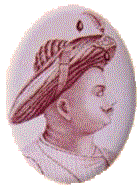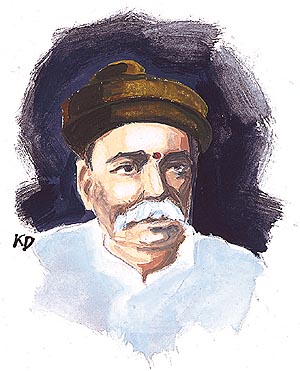

Who was Kalidasa? No one quite knows. After composing some of the best lyrical poetry ever, (in Sanskrit), little is known about him. His life lives in his works. Who was Ved Vyasa - the writer of Mahabharata? Or for that matter Valmiki! No one knows. About any one of these people.
Yet, whenever, India had needed, inspirations have come. To lead us … असतो मा सद्गमय From untruth to the truth … तमसो मा ज्योतिर्गमय … From darkness to light … मृत्योर् मा अमृतं गमय … from termination, to eternity …
 Tipu Sultan unceasing opposition for more than 30 years (The Mysore Wars - 1767-1799) to the foreign rule before the 1857 War made the British rulers cautious about waging war in India. Immediately thereafter was the challenge of the Sikh qaum - led by Ranjit Singh. The death of Ranjit Singh
Tipu Sultan unceasing opposition for more than 30 years (The Mysore Wars - 1767-1799) to the foreign rule before the 1857 War made the British rulers cautious about waging war in India. Immediately thereafter was the challenge of the Sikh qaum - led by Ranjit Singh. The death of Ranjit Singh in (1839) gave them another opportunity. Then followed the Afghan wars and the Sikh Wars (between 1839-1850). In 1857 was the India’s first war of Independence.
in (1839) gave them another opportunity. Then followed the Afghan wars and the Sikh Wars (between 1839-1850). In 1857 was the India’s first war of Independence.
From 1857 to the 1900, the British colonial government decimated Indian leadership. Bahadur Shah Zafar was sent to Rangoon. Rani Lakshmibai of Jhansi. Ahalyabai Holkar. Tantia Tope. Leader after leader came to the fore. And India continued to redefine itself.
 From feudal and hereditary leaders, the leadership slowly changed. From political to social. In parallel. In 1828, Raja Ram Mohan Roy formed the Brahmo Samaj. In 1875, Swami Dayanand formed the Arya Samaj. On 24th December 1892, Swami Vivekananda reached Kanyakumari - after travelling across India. He was entertained by rajas and the रंक
From feudal and hereditary leaders, the leadership slowly changed. From political to social. In parallel. In 1828, Raja Ram Mohan Roy formed the Brahmo Samaj. In 1875, Swami Dayanand formed the Arya Samaj. On 24th December 1892, Swami Vivekananda reached Kanyakumari - after travelling across India. He was entertained by rajas and the रंक (commoners) of his day.
Then followed the political leadership. Dadabhai Naoroji’s (Congress President in 1886, 1893 1906) and research and quantification of the British Loot from India started a new set of leaders against colonial rule - and a new definition of India. Tilak’s demand for ’swaraj’ and ’swadeshi’ goods unnerved the colonialists. The colonial British Government deported Balgangadhar Tilak to Rangoon. He came back stronger than before. In other countries, when old leaders and rulers were removed or replaced, those countries  descended into dictatorship, confusion, poverty. In India, we had wave after wave of leaders - and each time India moved forward. In a direction which has no precedents in world history.
descended into dictatorship, confusion, poverty. In India, we had wave after wave of leaders - and each time India moved forward. In a direction which has no precedents in world history.
What Happened In Other Countries
Why do Australia and Canada still acknowledge the British Queen as the head of the state? Spain has Juan Carlos I as its king! Did you know that Belgium has Albert II as it King? And Queen Beatrix rules over Holland (The Netherlands). King Akihito is venerated by the Japanese - and is the head of the state. Sweden is ruled by King Carl XVI Gustaf. Luxembourg has the Grand Duke Henri as its equivalent to a King! King Harald V lords over Norway! Queen Margrethe II rules over Denmark. The world still has quite a few monarchies - especially in the OECD. Why?
France removed and guillotined the monarchs - and they got Napoleon Bonaparte, as dictator! Russia tried - and they got 70 years of communist dictatorship. Italy asked King Victor Emmanuel III to go - and got Mussolini. The British exiled the Kaiser of Germany - and the Germans had to put up with Hitler thereafter.
Britain terminated the Turkish Ottoman Empire - and Turkey got a benign dictator, Mustafa Kemal Attaturk, and then not so benign dictators - and is yet to recover! East Europe (Romania, Poland, Czechoslovakia, Albania, etc) promptly started fighting with each other, within and without - after the kings were removed. China became communist after the last emperor - and still has a communist dictatorship. Iran, Egypt, Iraq, Libya, most of Africa, South America - same or similar story.
This history is why Canada and Australia cling to the skirts of British Monarchy.
Republican Democracy
America became one of the first successful Republican democracies - from 1789, when George Washington became the first elected President of USA. (70 years later there was a Civil War). America survived.
Israel, (propped up by massive US aid) is another country which has been a republican democracy for more than 50 years. Switzerland (with guaranteed neutrality from the European powers) is another in modern history to survive 50 years of republican democracy. Srilanka has been another country which has survived 50 years as republican democracy - but just about.
India is the youngest Republican democracy - and we have completed a historic 50 years as republican democracy - Jan 26th 1950, till date.
Gandhiji’s Conquest
But before the republic, came the unification of India - the crowning achievement of Gandhiji. Not the political union (achieved by Sardar Patel) - but the ideological union!
Garibaldi (united Italy), Bismarck (united Germany), Simon Bolivar (liberated and united South American countries) were unifiers who succeeded with the help of armies.
Gandhiji (armed with a walking stick) unified a larger India (and Pakistan) without an army. An India and a Pakistan - bigger than what the largest empire in the history of the world, the British Empire could not conquer with its armies.
One Clean Break
To make a one clean break from the feudal-colonial past - and succeed! That is a dream - never before in the history of the world. India made history - by surviving for 50 years with a republican democracy.
In 1947, India was a feudal society with more than 500 Kings and (some) Queens at the time of Independence. (No, the British did not rule over all of modern India). Large parts of India also had to change from a colonial mindset.
How Is India Unique
However, no other country has 15 official languages.
Switzerland has only 4. Sri Lanka’s Sinhalas do not want to accept Sri Lankan Tamils as full and equal citizens - hence the 20 year old civil war.
Social Equality
Blacks in the USA got full and equal liberty only in 1963 - after President Kennedy sent in the army (the National Guard). De-segregation (between the Blacks and Whites) happened clearly and fully only by 1970-75. It took the death of Martin Luther King (inspired by Gandhiji’s) in 1968 to do that.
But, Gandhiji’s first step, after coming back from South Africa, (many decades before India’s Independence, Unification and the creation of the Republic) was to start social reform against untouchability.
Enforcement - or Help
India and America, created their own constitutions without external enforcement. Republican democracy in Germany was imposed by the Allied Powers - hence their record is blemished.
Religions
In most countries, religion divides. In India, we are different. India has the world’s second /third largest Muslim population. The Indian Christian population is equal to that of most majority-Christian countries - excluding just a few big one like USA, Russia, Mexico, Brazil, etc. Buddhists number nearly 50 lakhs. Sikhs, Parsis (Zoorastrians), Bahais, follows their own religion. Iranians, Armenians, Jews, Chinese have come to India - when persecuted in their homelands.
Racism! Anyone?
No, thanks!
India has the Caucasoid stock - spread over the North and West India; Australoid stock spread over South India and the Mongoloid stock spread over of East and North East. There is also a very small sprinkling of the Negroid stock - less than 1%.
The Challenges Ahead
The challenges ahead are defence and economics.
India’s defence unpreparedness is beyond comprehension. Worse, is the lack of threat perception. Indians (sadly and truly) limit their threat perception to the Pakistanis - and the Chinese. with the world’s largest private reserves of gold India becomes a target. The resultant global and emerging threats are unrealised. We spend billions of dollars on buying arms all over the world - but our domestic arms industry is starving.
The second is economics. The world trade systems, financial agreements, currency management continue to drag down India - and many other countries. Navigating these uncharted waters successfully is the other.
And I am sure that another set of new leaders will arrive and take India forward to another level.
Sooner - not later.
No comments:
Post a Comment